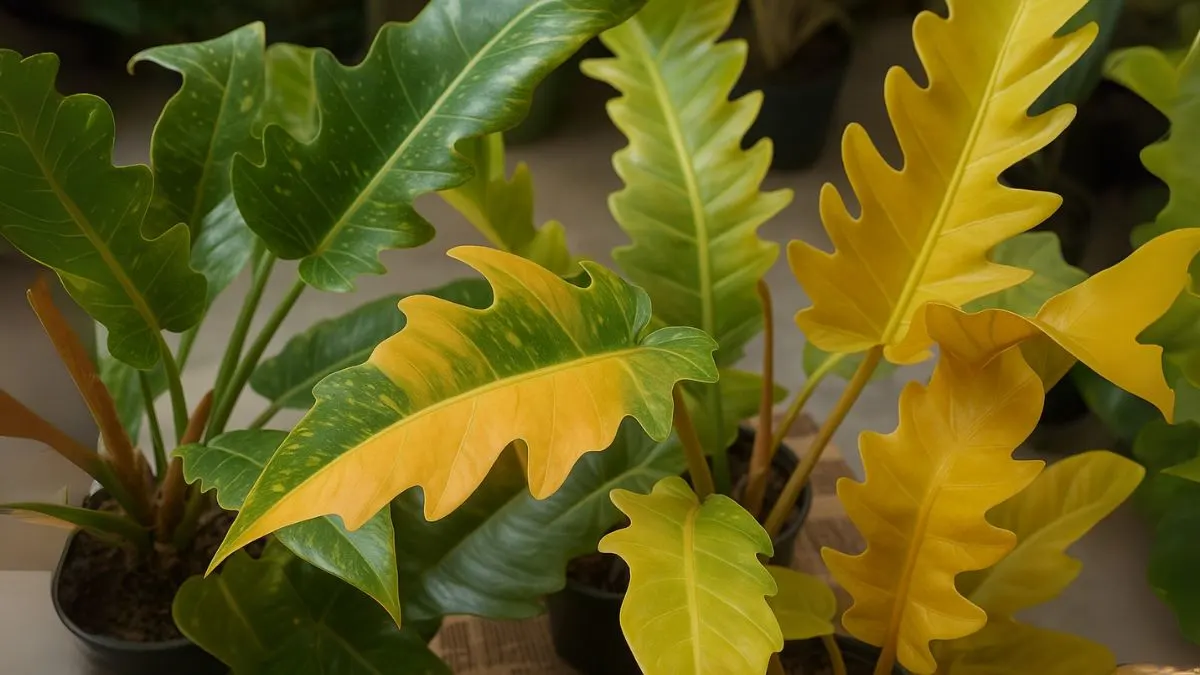If you’ve ever wanted a statement plant that instantly turns your living room into an exotic jungle, the Philodendron Ring of Fire is the one. Known for its colorful, jagged-edged leaves that look painted in flames, this rare philodendron is both a collector’s dream and a beginner-friendly plant.
But before you get one, you need to know the basics. From light and water requirements to growth patterns, this guide covers all the care tips and tricks you’ll need to help your Philodendron Ring of Fire thrive indoors.
What is the Philodendron Ring of Fire?

The Philodendron Ring of Fire is a tropical plant believed to be a hybrid of Philodendron Wendlandii and Philodendron Tortum. What makes it special is its variegated foliage—a mix of green, orange, yellow, cream, and even pink tones that change depending on light exposure.
Unlike trailing philodendrons, the Ring of Fire has a more upright, spreading habit. Its leaves can grow up to two feet long, giving the plant a bold, architectural look.
Light Requirements
Lighting is the single most important factor in keeping this plant happy. Always place your Philodendron Ring of Fire in bright, indirect light. Direct sunlight can scorch the delicate variegation, while low light reduces the fiery colors.
- Light: Prefers bright, indirect light near east- or north-facing windows.
- Avoid: Prolonged direct afternoon sun.
- Pro tip: Rotate the plant weekly to ensure all sides receive equal exposure.
From personal experience, I noticed my Ring of Fire lost its orange tones when placed in a darker corner. Once I moved it closer to a window with filtered light, the colors came back stronger.
Watering Needs
When it comes to watering, less is more. Overwatering is the most common mistake. Remember: they’re generally easy to care for as long as you don’t overwater.
- Water when the top 2 inches of soil feel dry.
- Ensure the pot has drainage holes.
- Reduce watering during winter dormancy.
If you’re unsure, it’s always safer to underwater slightly than to let the roots sit in soggy soil.
Also Read: Bamboo Palm Plant: The Perfect Green Companion for Fresh, Healthy Living
Soil and Potting Mix
The Philodendron Ring of Fire prefers a chunky, well-draining mix that mimics its natural tropical habitat.
A simple recipe:
- 40% peat moss or coco coir
- 30% perlite
- 20% orchid bark
- 10% compost
This combination allows roots to breathe while holding enough moisture for steady growth.
Humidity and Temperature
As a tropical plant, the Ring of Fire thrives in warm, humid environments.
- Temperature: Keep it between 65–85°F.
- Humidity: Aim for 60% or higher.
If you live in a dry climate (like parts of Canada or the U.S. during winter), use a humidifier or place a pebble tray under the pot. I personally mist mine occasionally, but consistent humidity from a humidifier worked far better.
Feeding and Fertilizer
For lush growth, fertilize monthly during spring and summer with a balanced liquid houseplant fertilizer. Cut back during fall and winter when growth slows.
👉 Over-fertilizing can damage roots, so always dilute to half strength.
Growth and Pruning
This plant is known for slow to moderate growth. It won’t explode overnight, but with the right care, it will steadily produce new leaves.
- Prune any yellow or damaged leaves.
- Wipe dust off the foliage to keep the variegation vibrant.
- Repot every 2–3 years to refresh the soil.
Also Read: China Doll Plant: A Stylish Evergreen for Modern Homes
Common Issues and Solutions
Problem |
Cause |
Fix |
Yellow leaves |
Overwatering |
Let soil dry, improve drainage |
Brown edges |
Low humidity or sunburn |
Increase humidity, move to indirect light |
Faded variegation |
Low light |
Provide it with plenty of bright indirect (or filtered) light |
Why It’s Worth Growing
The Philodendron Ring of Fire is not just another indoor plant. Its fiery variegation makes it a conversation piece, while its forgiving nature makes it beginner-friendly. It’s rare, often pricey, but worth the investment for anyone who wants a unique addition to their plant collection.
If you’re looking for a low-maintenance but high-impact plant, this one will not disappoint. Whether you’re in Canada, the U.S., or anywhere across the world, this philodendron can be your ultimate indoor showstopper.






